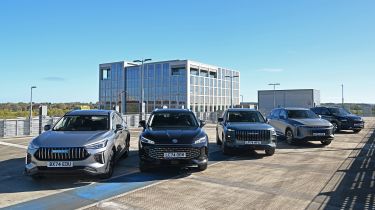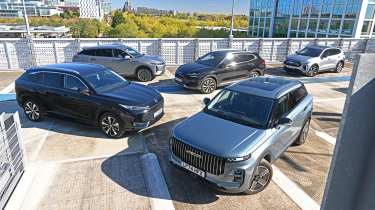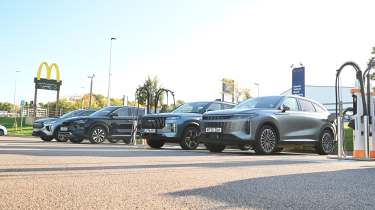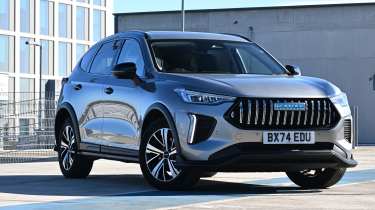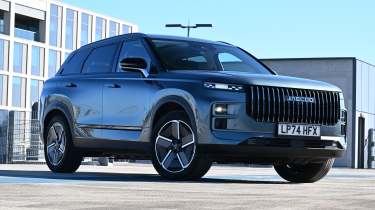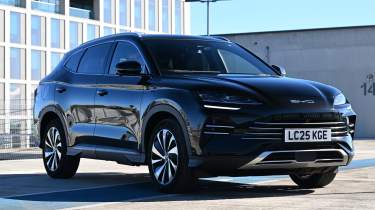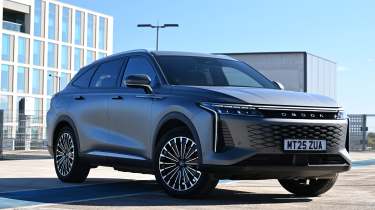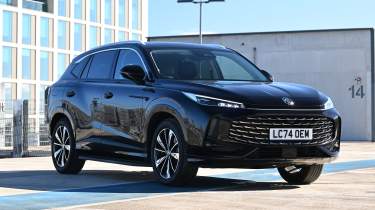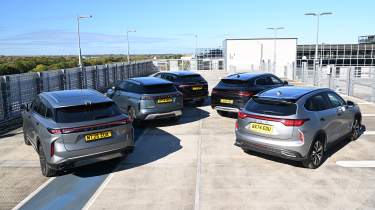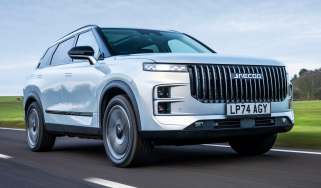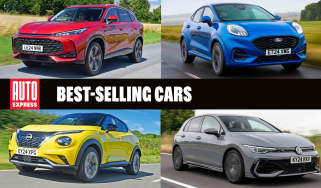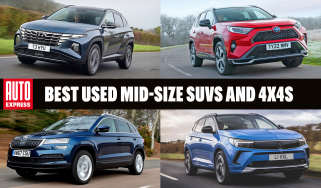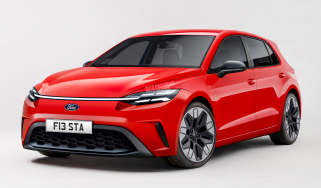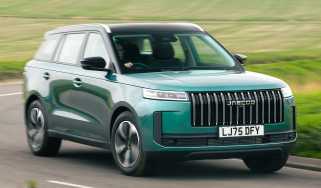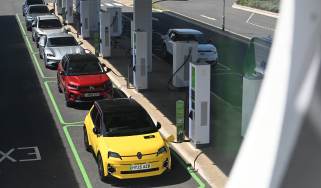Chinese hybrid mega test: the truth about PHEV range and efficiency
There’s a tidal wave of Chinese SUVs hitting our shores, but are they any good? We test five new hybrid models to find out
If you find yourself sitting in traffic or travelling down the motorway this week, take a look around you. What do you see? Chances are, there will be a handful of cars you barely recognise, from manufacturers and makers you’ve possibly never heard of. The Chinese automotive invasion is in full swing – and British roads are living proof of it.
It’s quite unlike anything we’ve experienced before. When the Japanese started making inroads to the UK back in the sixties, the size of the new-car market was a fraction of what it is today. The Koreans came in the eighties and nineties, but it was decades before anyone took them seriously; the class-leading Hyundais and Kias we drive today are a far cry from the cars that brought the brands to Britain all those years ago.
But with the onslaught of electrification gathering momentum – hybrid, plug-in hybrid and fully-electric cars accounted for more than half the market in September – buyers are at a crossroads. Many are asking whether now’s the time to part ways with Peugeot, say ‘au revoir’ to Renault, or veto their Vauxhall. Some may even be ready to turn their back on Europe’s big premium players.
But is there more to these state-backed SUVs than a temptingly low list price? Should they warrant your attention, and can they hold a candle to a car industry that has been operating without a new threat for the best part of three decades?
The cars
To find out, we’ve pulled together five Chinese hybrid newcomers to pick apart every key consideration that a potential buyer might face. We’ll look at things like efficiency, practicality, kit and quality, as well as what they’re like to drive, plus the most important point of all: value for money.
We’ve covered the infiltration of China in Europe fairly extensively; of the five brands here, only MG had a presence in the UK three years ago – and just one of the maker’s line-up then still exists today.
The plug-in hybrid MG HS was only revealed in 2024, yet claims its title as the seventh best-selling car this year; as you read this, more than 25,000 will have been registered in 2025, via the company’s 70-strong (and growing) dealer network.
BYD has risen from nothing, launching no fewer than eight separate models in a little more than two and a half years. The Seal U DM-i – another plug-in hybrid SUV – is a strong contender in the mid-size family SUV segment; 5,373 found homes in September, making it the country’s sixth-biggest seller last month.
Of our quintet, the Jaecoo 7 is arguably the most intriguing. Despite the brand only launching in the UK early part of this year, it has shot to stardom almost overnight; the 7 is already the most searched-for car on Carwow’s Buy A Car service – knocking the Kia Sportage and Hyundai Tucson from their long-standing tussle for top spot.
But while the BYD, Jaecoo and MG all operate in the mainstream part of the market, the Omoda 9 is a different proposition. Starting from whisker less than £45,000, this is a 443bhp premium plug-in hybrid pitched as an alternative to cars like the Audi Q5 and BMW X3.
While that sounds like a stretch, you might think differently when you consider the sizeable price difference; the Omoda is more than £13k cheaper than the statistically inferior X3.
The final car is the Haval Jolion Pro. It’s from parent company GWM, which brought us the Ora 03 (formerly Funky Cat) and more recently, the Poer 300 pick-up. Unlike the BYD, Jaecoo, MG or Omoda, the Haval doesn’t have a plug; instead, this full hybrid comprises a small battery, electric motor, and a 1.5-litre petrol engine, feeding power through a two-speed gearbox to the front wheels. It’s also the cheapest car here by some margin.
Battery charging speeds
The day starts at Brewpoint Bedford giving us the plug availability to hook up each of the PHEVs, while parking the Jolion Pro to one side. Of course, this task would normally be done at home, but for the fairness of our test, we want to charge each to 100 per cent before zeroing the trip computers.
And hereby presents our first challenge. The BYD, Jaecoo and Omoda all come with CCS fast-charge capability, but the MG makes do with a slower Type 2 connector. Astonishingly, the HS’s dash readout tells us that charging from 65 per cent to full will take almost two hours drawing just 4kW. We head inside for a coffee.
Not wishing to do the MG a disservice, the three other PHEVs do, admittedly, offer quite a variety of charge speeds. The BYD, for example, peaks at just 18kW, which makes plugging in to an (expensive) rapid charger somewhat futile. That said, during our test, it pulled strongly from the start; we see 17kW at 26 per cent state of charge – suggesting we’ll be at 80 per cent in just over half an hour.
The Jaecoo’s 40kW maximum is considerably quicker, although you’d still need to weigh up whether 82 pence per kWh (on Osprey’s flat rate charging tariff) is worth the expense. To our minds it’s not – at that price, you’d need to average more than 5.3mi/kWh to match a petrol car doing 40mpg. It makes the act of plugging in away from home a fruitless endeavour – even if we notice the 7 replenishing at up to 33kW, deep into its extended charge curve.
The Omoda, meanwhile, beats some early EVs for ultra-fast top-up times. The BMW i3, for example, never exceeded 50kW, even late in its decade-long production run. This Chinese SUV, despite having a four-cylinder petrol engine and dual electric motors fed by a whopping 34.5kWh battery, recharges at up to 70kW – good for a theoretical 30 to 80 per cent refill in “just over 20 minutes”. In reality, we see it slow to just 13kW at 78 per cent charged – at which point it trickles home barely any faster than the MG.
The test
With the cars (and Auto Express staffers) all topped up to 100 per cent, we can zero the trip computers. In a process honed over several decades, most European cars can perform this menial task via the press of a single button on the steering wheel or dashboard. But as we find out, the Chinese want you to work for your lunch. We spend an inordinate amount of time resetting each car; the Haval takes the prize for being hardest to fathom – an issue we’ll delve into further as the day progresses.
We’ll be running each of the cars in their default drive mode, which varies between ‘Eco’ and ‘Normal’ across the five models. This seems like the fairest way to test, along with the climate controls set to a comfortable temperature and in their automatic setting; it’s not a particularly warm day, so none of the systems will be working overtime trying to keep the cabin cool.
Haval Jolion Pro
| Model: | Haval Jolion Pro |
| Price: | £29,995 |
| Powertrain: | 1.5-litre 4cyl petrol hybrid |
| Power/torque: | 186bhp/375Nm |
| EV range: | N/A |
| 0-62mph/ top speed: | 9.0 seconds/115mph |
| Size (L/W/H): | 4,470/1,898/1,625mm |
Our first destination is Milton Keynes, around 18 miles from our start point. It takes in a variety of roads, but nothing that our plug-in hybrids can’t complete entirely on battery power. I begin proceedings in the Jolion Pro – not only because it’s the most affordable car in our line-up, but also because its tiny battery means we’ll be leaning on the petrol engine as soon as we leave base. It represents a total departure from the Volkswagen Golf I drove up to Bedford this morning – in more ways than one.
I don’t consider the Jolion to be quite the bag of nails that my colleague Jordan does (see his tester’s note) but it does feel like the powertrain is writing a cheque that the chassis can’t cash. The punchy electric motor means it feels more electric than some hybrids, certainly at low speeds, but pushing on through some of the faster, more flowing stretches close to Milton Keynes it feels out of its depth; the Kia Sportage, Nissan Qashqai and Volkswagen Tiguan are almost infinitely more composed, even if they cost considerably more in the first place.
But value comes down to more than list price. It’s about the entire package, and too much lets the Haval down for it to represent even mediocre value for money. The cabin is spacious enough, but the 255-litre boot is tiny and leaves this family SUV more closely aligned to petrol city cars than even the most compact of crossovers.
Yet the most frustrating thing about the Jolion Pro is its glitchy infotainment system and frankly baffling user experience – something we’ve already experienced when trying to reset the car’s trip computer. The instrument cluster, for example, shows its units in miles, while the central screen lists key information in kilometres – with seemingly no option to change it. The layout with which the stats are presented feels as if you need a doctorate to decipher, too. The less said about the stuck-on DAB aerial attached to the windscreen, the better.
Tester’s notes
“The Jolion Pro feels like a developing-market car that’s been modified to sell in Europe. The Haval has been stuffed with a relatively powerful hybrid powertrain and technology interfaces that were never initially designed to fit. Everything feels imprecise, from the ride and handling, which is stiff-legged and unsophisticated, to the body roll and steering that’s unable to really handle the torque being produced by the powertrain.
Despite decent pick-up from the e-motor and the ability to manoeuvre on battery power alone, the engine is noisy, with a tendency to drone under heavy loads or at high speeds.” - Jordan Katsianis, senior staff writer.
Jaecoo 7
| Model: | Jaecoo 7 PHEV |
| Price: | £35,165 |
| Powertrain: | 1.5-litre 4cyl petrol PHEV |
| Power/torque: | 201bhp/310Nm |
| EV range: | 56 miles |
| 0-62mph/ top speed: | 8.5 seconds/112mph |
| Size (L/W/H): | 4,500/1,865/1,680mm |
It’s refreshing, therefore, to hop from the Haval into the Jaecoo 7. Theoretically, of our four plug-in hybrids, this has the shortest electric-only range. Its maker claims it’ll do 56 miles before needing to be plugged in – plenty more than first-generation PHEVs like the Mitsubishi Outlander, but still around 20 miles shy of both the BYD and MG tested here.
Despite looking a bit like a shrunken Temu Range Rover outside, the Jaecoo immediately feels better built. There are premium-ish materials dotted around, the centrepiece of which is a large, tablet-like infotainment screen in the middle of the dash.
The chunky central transmission tunnel houses a big storage cubby, two cup-holders and a pair of wireless phone chargers, one of which is cooled via a tiny fan – a certified boon for anyone who has had their device overheat while attempting to run media and maps simultaneously via Apple CarPlay or Android Auto. Window switches that operate in the opposite direction to what you expect can be filed in the irrationally annoying column, however.
Being able to cover more than a few metres on electric power makes the Jaecoo feel much more mature – and modern – than the Haval, but with less than 20 miles on the trip computer, we’re still a long way from needing the petrol engine to take over proceedings. Pootling around town, the 7 is a perfectly agreeable thing to drive, keeping up with traffic and manoeuvring elegantly through gaps and over street furniture. The ride’s a little fidgety, but far from a dealbreaker.
However, things start to come undone as we increase the pace. Milton Keynes is famous for its countless roundabouts and quick dual carriageways – and neither of them feels like the 7’s friend. The front end often appears to be disconnected from the driving experience, and mid-corner bumps upset the car’s balance.
Despite these faster runs, all while trying to keep up with editor-at-large Phil McNamara in the Omoda, the Jaecoo manages 53 miles (just three miles short of its publicised official range) before flashing up a warning message on the sharp 13.2-inch touchscreen: “The battery of your vehicle is low. It is recommended to switch to the intelligent power saving mode,” it reads.
At this point, with 17 per cent battery remaining, the car automatically fires up the petrol engine. It does mean that, in theory, the Jaecoo could go further on electricity, but the car’s clever internals preserve a certain level of charge. Once the engine kicks in, we see the battery level climb; the Jaecoo refuses to operate solely in EV mode until the cells are sufficiently replenished.
Tester’s notes
“Light’, ‘glutinous’, ‘like an errant toddler’ – going back through my notes skewers the steering on all these cars bar the MG. The toddler in question was the Jaecoo 7, which needed a lot of attention to stay on course.
But the drivetrain is pretty good, with decent punch and only serious acceleration firing up the petrol engine. Indeed the throttle triggers some torque steer, with the front end also skipping over bumps under acceleration. I love the simplicity of two big buttons to toggle between pure electric and hybrid, but wish Jaecoo had applied the same effort to the window switches.” - Phil McNamara, editor-at-large.
BYD Seal U
| Model: | BYD Seal U DM-i Comfort |
| Price: | £35,315 |
| Powertrain: | 1.5-litre 4cyl petrol PHEV |
| Power/torque: | 214bhp/300Nm |
| EV range: | 78 miles |
| 0-62mph/ top speed: | 8.9 seconds/105mph |
| Size (L/W/H): | 4,775/1.890/1,670mm |
Now, I switch into the BYD, which alongside the MG, should manage more than 70 miles before defaulting to petrol power. Yet exactly as in its competitor, the Seal U DM-i’s battery readout is still showing around 20 per cent charge when the display shows zero miles remaining. We’ve covered just over 66 miles on electric power at this point, giving the BYD the third longest EV range of the cars on test.
As the miles tick by, I barely notice the transition from electric to combustion power, and if I hadn’t been monitoring the range readout on the dash, I think it would have passed me by entirely. The switch in the BYD feels smoother than it did in the Jaecoo, adding to a strong overall sense of comfort and refinement.
I’m thankful to be driving the BYD for our chunky stint north towards Leicester, on an unusually free-flowing M1 motorway. This confirms my thoughts from driving the Seal U DM-i on the international launch last year, in that the softly sprung SUV is better suited to this kind of route, rather than rural roads with fast changes of direction. If this tallies with your driving style, or you spend a lot of time in town, the BYD is a perfectly pleasant place to be.
With the novelty rotating touchscreen in its landscape orientation, we can sit back and revel in the Seal U’s premium-feeling interior. It doesn’t offer Mercedes levels of luxury, but for the price (from £33,315 in base Boost trim) it’s easily a match for its mainstream European rivals. It trumps almost every one of them for space, too; the BYD feels big, both in terms of its outright footprint, as well as roominess inside. The raised driving position gives a good view out, and you won’t struggle to fit taller adults in the back. Its boot is slightly on the small side though, and there’s only a little under-floor storage, so the charging cables will need to sit alongside your luggage.
While I’ve been driving the BYD, Phil notes that the MG’s battery manages just one mile shy of its official, WLTP-stated maximum. The fact it has returned 74 miles of electric-only running over such a varied – and often high-speed – test route is astounding. Unless the Omoda can surpass its quoted 93-mile range, the HS will take the crown as the model that comes closest to its advertised numbers, which as we well know, is no mean feat.
Tester’s notes
“The BYD Seal U is arguably the car I have the least to say about, which in itself, tells you everything you need to know. Yes, it’s handling is a bit floaty, but the in-car technology is on point, and it displayed reasonable efficiency.
It also had a strong 66-mile battery range. But answer me this: why fit a CCS rapid-charge connector to a car that can pull barely 20kW on a suitable DC public charger? No one’s going to plug it in away from home – and it just adds unnecessary cost and complexity to a car that could be even more of a bargain than it already is.” - Richard Ingram, deputy editor.
Omoda 9
| Model: | Omoda 9 SHS |
| Price: | £44,990 |
| Powertrain: | 1.5-litre 4cyl petrol PHEV |
| Power/torque: | 443bhp/700Nm |
| EV range: | 93 miles |
| 0-62mph/ top speed: | 4.9 seconds/124mph |
| Size (L/W/H): | 4,775/1,920/1,670mm |
As I swap into the Omoda 9 at our next stop, I get an almost identical message to that in the Jaecoo – no surprise considering both are owned by parent company Chery – suggesting the car is set to switch into its intelligent power-saving mode. There’s some confusion, however, because the trip readout is showing 102.9 miles covered since we set off – 10 miles more than its official figure.
Delving into the car’s menus, I notice a tab that lists the amount of fuel used since we reset the trip computer: 4.2 litres. It seems the Omoda has been secretly sipping petrol without any of us realising, which is credit to its refined powertrain, of course. But it poses a problem when analysing efficiency, and forces us to think on our feet.
Resetting the trip once again, we keep an eye on how many miles we cover before using another 4.2 litres of fuel – before subtracting that number from the 102.9 miles we’d previously covered. The result is around 26 miles – suggesting the Omoda 9 is capable of 76-77 miles in EV mode. That makes it the longest-range PHEV here, but hands the MG the award of coming closest to its maker’s claim.
My biggest takeaway to this point is that the Omoda is definitely the car with the chance of pulling premium prospects away from European stalwarts such as Audi, BMW and Mercedes. It feels heavy, stable and well engineered – aside from the grabby brake pedal, that is – with plenty of high-end materials and features in the cabin. The twin-screen infotainment system is encased within a single, curved display, while the chunky rotary dials on the centre console operate with a lovely tactility. The hard trim on the centre armrest is exactly where you rest your elbow, though.
Tester's notes
“The Omoda’s interior was simple to navigate. It let me set a nav destination and control the air-con with centre dials; I found the whole thing pretty premium, which it should be. Drive-wise, however, it felt a bit heavy and underpowered – and certainly shy of Omoda’s claimed 443bhp.
At one point, I took a sharp corner at speed, and the body roll was truly nasty. Saying that, I liked it better than the Jaecoo, which felt rather loose at the front end. Perhaps most telling was how much I enjoyed hopping back into my Cupra at the end of the day; the difference in how the two cars drove was marked.” - Darren Wilson, creative director.
MG HS
| Model: | MG HS PHEV Trophy |
| Price: | £34,745 |
| Powertrain: | 1.5-litre 4cyl petrol PHEV |
| Power/torque: | 295bhp/350Nm |
| EV range: | 75 miles |
| 0-62mph/ top speed: | 6.8 seconds/105mph |
| Size (L/W/H): | 4,670/1,890/1,663mm |
My final stint back towards base comes courtesy of the MG HS. As mentioned, this is the brand with the most recognition in the UK, even if you discount the equity it built assembling classic MGBs in the sixties and seventies, or MGFs in the late nineties.
It certainly feels the most familiar, and the most akin to a European, Japanese or Korean SUV. Quality is good enough considering the price, and refinement is excellent – even on rougher roads or concrete sections of motorway.
Although the battery is, in effect, empty, the car still manages to juggle its power sources without much interruption – pulling away using the electric motor, before engaging the combustion engine as needed. The steering is a little slow, but the benefit of this is that it doesn’t feel at all twitchy on faster roads, making it a relaxing thing to drive.
It’s quite the contrast to the almost incessant beep and bongs that have accompanied our test today. None of these Chinese SUVs is immune from the relentless, nannying safety aids that their makers will claim are there to help you, when in reality, they do more to distract you than focus your attention on the road ahead. They can be turned off, of course, although rarely very easily; this is a distinct point of difference whereby European rivals better cater to localised tastes, and an undisputed area for improvement when it comes to the new brands convincing British buyers that we really should take these Chinese newcomers seriously.
Tester’s notes
“The MG seemed better able to stick with EV power than the others; the 181bhp electric motor has enough poke on its own, and even at motorway speeds the petrol engine isn’t required and therefore doesn’t force the car to switch to HEV mode. The steering in the MG is the best of the bunch, even if it’s a little delayed in its responses.
Ultimately, it felt the most European of the cars we tested – perhaps a little brittle over rough ground, but soft suspension helps give it a comfortable ride overall. It settled down on the motorway, too – thanks at least in part to that well calibrated steering.” - Alastair Crooks, senior news reporter.
Which Chinese plug-in hybrid SUV was the most efficient?
One final calculation that needs completing before we sign off is an assessment of average fuel economy after the hybrid batteries ran out of charge. No car shamed itself in this regard – it seems days of lugging around a heavy battery for little to no benefit are behind us, although some performed better than others.
Indeed, we didn’t expect the lightweight Haval to finish bottom of the pile; 44.1mpg is by no means disastrous, but without the hefty high-voltage battery of its competitors, we expected more.
Both the MG and Omoda managed to return 44.8mpg, which shows the latter in a particularly positive light given it’s also the heaviest car here, and the only one that exceeds two tonnes.
The BYD returned a strong 47.9mpg with a discharged battery, which is comfortably more than you’d expect for a petrol or even hybrid car of this type – the revised Kia Sportage managed just 43.8mpg in our latest road test.
But the true champ when it comes to engine-on fuel economy was the Jaecoo 7 PHEV, which posted a solid 51.4mpg on the trip computer. While we wouldn’t recommend doing so, it provides proof that if you wanted or needed to, you could run any one of these without fear it’s hammering your bank balance – even without plugging it in at every opportunity.
Verdict
It’s difficult to rank these cars in any definitive order, given that only a couple can be considered direct rivals. That said, if push comes to shove, which of these Chinese newcomers should command your hard-earned cash, and which – after a constricted, short and snappy lifecycle – should be consigned to the history books?
To answer the latter part of that question, the only car we truly struggle to recommend is the Haval. It might be cheap, but it’s far from cheerful. The driving experience is lukewarm at best, while the infuriating infotainment and general user experience is nothing short of appalling. It’s rare that a company gets the fundamentals so wrong, but the Jolion Pro is a car that falls so far short of European tastes that it should be sent back on a boat to the country it came from. Buy a used Nissan Qashqai e-Power – you won’t regret it.
The Omoda 9 sits at the opposite end of the scale. But while it might cost almost twice as much as the Haval, it’s unquestionably twice the car. There’s little wrong with it, in all honesty, aside from the lacklustre drive and grabby brakes, but at this price point it needs to do more to stand out. It’s difficult to see buyers chopping in their premium-badged BMWs for the chance to drive an Omoda – even if the 70-odd miles of electric running could work wonders for your company-car tax bill.
The most well known models each do just enough to warrant significant attention if you’re in the market for an electrified family SUV that can do everything their European counterparts can but for a fraction of the price. The Jaecoo is the most design-led (or should that be Range Rover design-led?) of the three remaining candidates, but it’s let down by a floaty, sometimes disconcerting driving experience. Strong ICE efficiency and a reasonable EV range claw things back, but ultimately, the 7 falls short of both the BYD and the MG.
The BYD is an attractive proposition, both in this company and in its own right. The company’s ambition cannot be overstated, and the billions it’s pouring into R&D is served well in the Seal U DM-i. It’s better suited to urban journeys or longer motorway trips, but the comfy cabin and snappy infotainment mean it’s no chore to drive. A strong EV range means it pips the Jaecoo.
Probably the biggest compliment we can pay the MG HS, which is our undisputed champion in this company, is that it felt the most European of all the cars tested here.
We found the HS to be impressively refined on the motorway, with little wind or road noise and a comfortable ride. Yet none of that came undone when it was faced with a challenging A or B-road – the slower steering stopped it feeling too alert or twitchy, and well contained body roll prevented its occupants from being thrown about too much.
Factor in the bargain price (our car was the top-spec Trophy version, but the cheaper SE starts from just a fraction more than £32k) and a hybrid battery range that falls just one mile shy of the manufacturer’s claim, and you’ve got a spacious family SUV that should be as easy and rewarding to live with as anything with a Skoda or Volkswagen badge on the bonnet. The MG HS PHEV is about as good as Chinese cars get.
Results
| Car | Price | Powertrain | Battery capacity | Official EV range | Distance covered | % of official range | Charge rate | ICE test economy |
| 1. MG HS PHEV Trophy | £34,745 | 1.5-litre 4cyl petrol PHEV 24.7kWh | 24.7kWh | 75 miles | 74 miles | 98.6 | 7kW (AC) | 44.8mpg |
| 2. BYD Seal U DM-i Comfort | £35,315 | 1.5-litre 4cyl petrol PHEV 26.6kWh | 26.6kWh | 78 miles | 66 miles | 84.6 | 18kWh (DC) | 47.9mpg |
| 3. Jaecoo 7 PHEV | £35,165 | 1.5-litre 4cyl petrol PHEV 18.3kWh | 18.3kWh | 56 miles | 53 miles | 94.6 | 40kWh (DC) | 51.4mpg |
| 4. Omoda 9 SHS | £44,990 | 1.5-litre 4cyl petrol PHEV 34.5kWh | 34.5kWh | 93 miles | 76 miles | 81.7 | 70kWh (DC) | 44.8mpg |
| 5. Haval Jolion Pro Ultra | £29,995 | 1.5-litre 4cyl petrol hybrid | 1.7kWh | N/A | N/A | N/A | N/A | 44.1mpg |
Our dealer network has 1,000s of great value new cars in stock and available now right across the UK. Find your new car…
Chinese cars on Auto Express
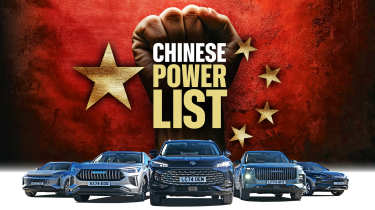
Confused by all the new Chinese car brands hitting UK roads? We've got you covered...
- Why are Chinese cars flooding the UK?
- The best and worst Chinese car brands in the UK: All 17 ranked and rated
- Chinese hybrid mega test: the truth about PHEV range and efficiency
- Top 10 UK cars you didn't know are made in China
- Best Chinese cars: the top options to consider for UK buyers
Find a car with the experts

